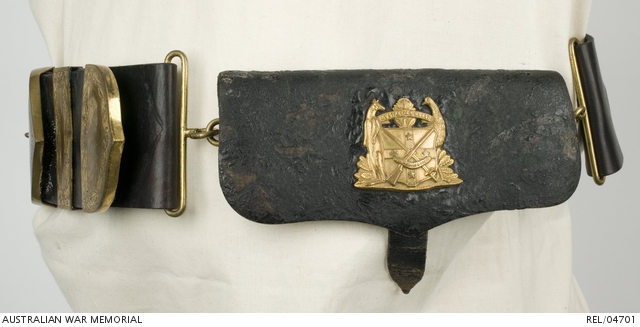| Place | Oceania: Australia, New South Wales |
|---|---|
| Accession Number | REL/04701 |
| Collection type | Heraldry |
| Object type | Uniform |
| Physical description | Gilded brass, Leather |
| Maker |
Unknown |
| Date made | c1898 |
| Conflict |
Australian Colonial Forces, 1854-1900 |
Officer's full dress shoulder belt and pouch : Lieutenant J B N Osborne, 1st Australian Horse




Officer's black leather full dress shoulder belt and pouch. The original engraved gilt brass buckle, slide and tip have been attached to a replacement belt of plain black leather although the original belt would have been made of black patent leather to match the pouch. The gilt chain and pickers, which would once have been attached, are missing. The black patent leather pouch bears a gilded badge of the 1st Australian Horse attached to the front flap. The badge depicts a kangaroo and emu supporting a shield bearing a square cross with five stars, which represent the Southern Cross. Superimposed on the shield are a crossed carbine and sword with a boomerang inscribed with the regimental motto 'FOR HEARTHS & HOMES'. The pouch has two internal pockets. There are cast brass fittings on each side of it to attach it to the shoulder belt.
Officer's dress shoulder belt and pouch worn by Lieutenant James Bunbury Nott Osborne as a member of the 1st Australian Horse. The first badges of the 1st Australian Horse were made in London and issued at the first Easter camp. The numeral '1' on the badge was only included from 1898 to 1900. Born on 14 May 1878, and educated at Rugby College in England, Osborne was commissioned into the 1st Australian Horse on 1 Jan 1898. During the Boer War, the Australian Horse provided two contingents, in 1899 and 1900. Osborne served as second in command with the first contingent, arriving in Cape Town on 13 December 1899. He was present at the relief of Kimberley and while there, left the Australian Horse and took up a commission with the British 16th Lancers. He was closely involved in the surrender of Bloemfontein. Osborne was involved with operations in Orange Free State and Transvaal from January 1900 to November 1900 and saw action at Reit River, Klip Drift, Relief of Kimberley, Paardeberg, Poplar Grove, Dreifontein, Karee Siding, Belfast and Slingersfontein. He was awarded the Queen's medal with five clasps. Aflter taking ill, he was invalided to England. Osborne eventually returned to Australia and took up the family property 'Bowylie', Gundaroo N.S.W. He died in 1934.